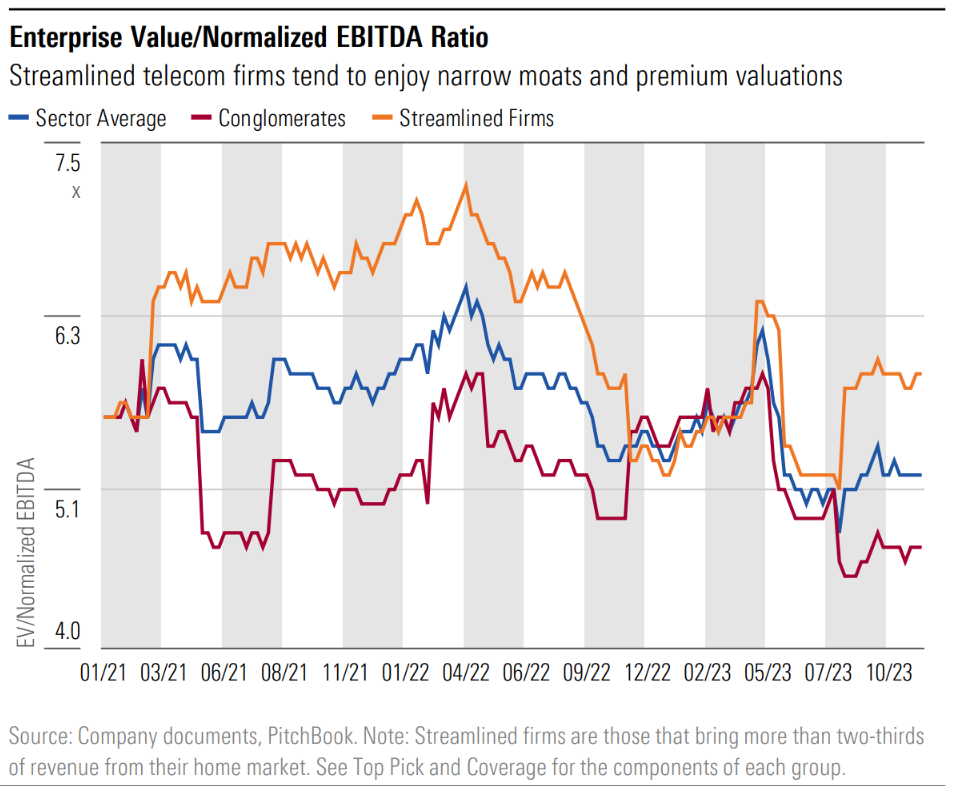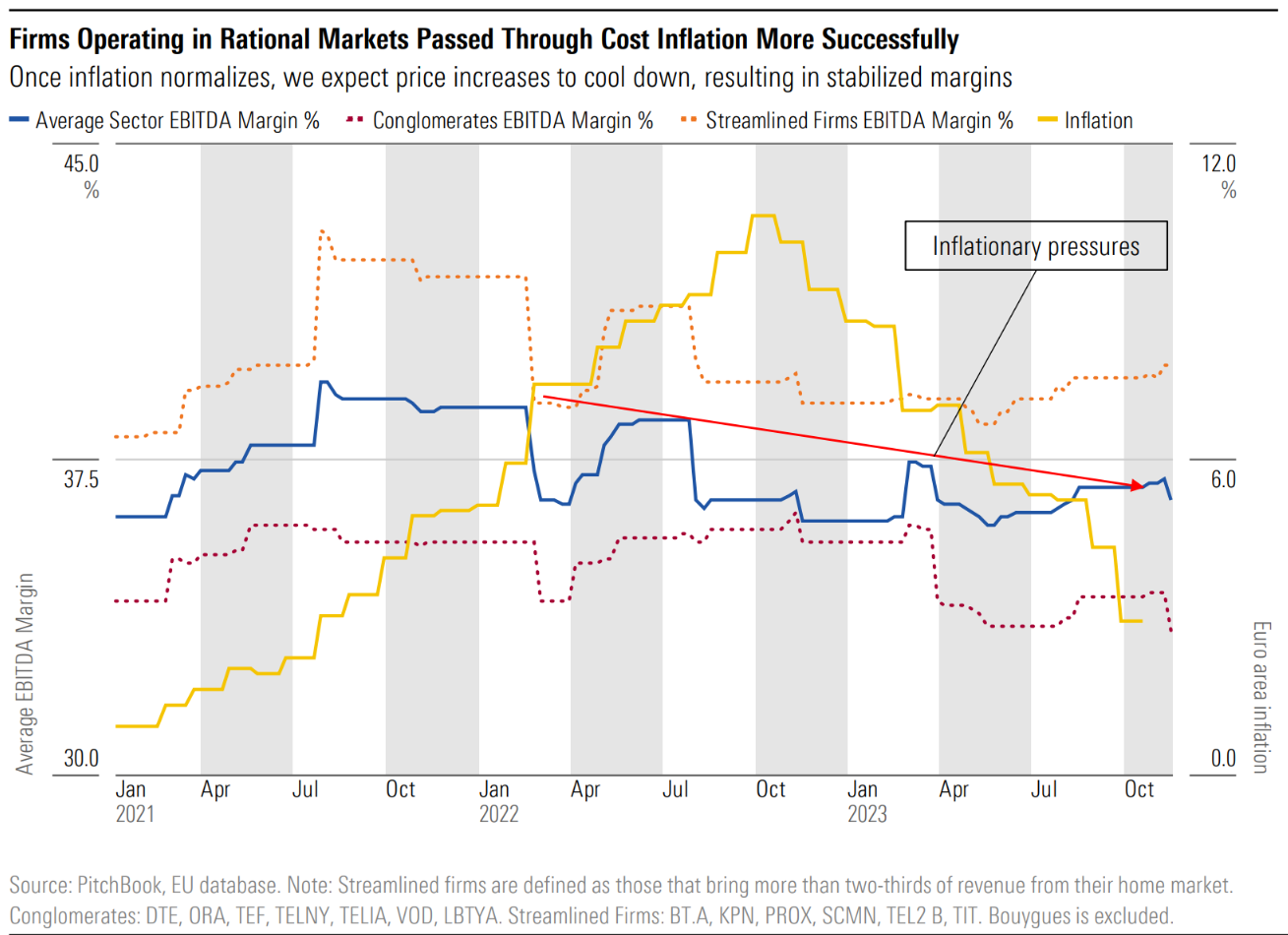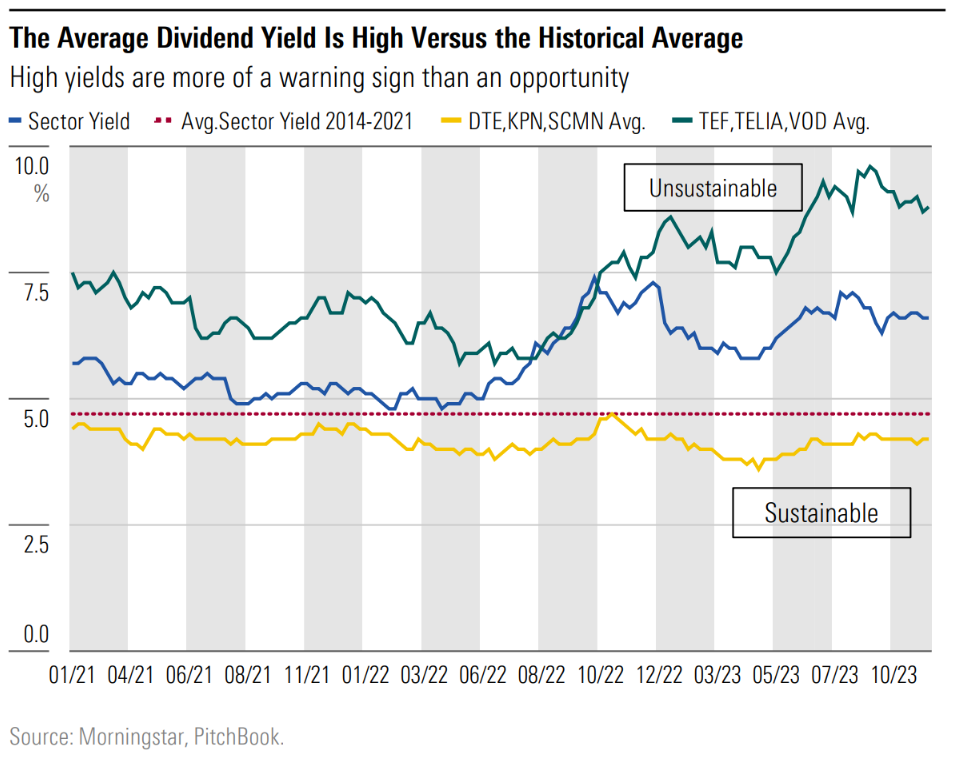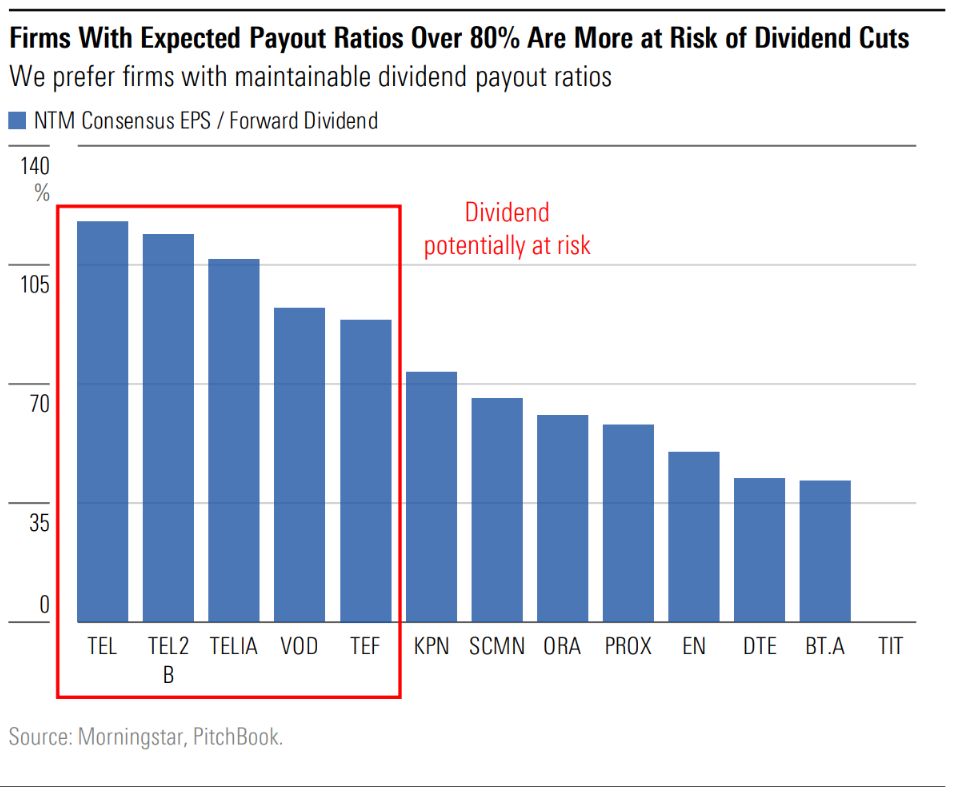In
Morningstar’s
inaugural
European
Telecoms
Pulse
report,
analyst
Javier
Correonero
takes
stock
of
the
sector’s
valuation
and
future
upside,
and
highlights
two
strong
contenders
in
the
space.
Telecommunications
conglomerates
are
trading
at
around
0.8
times
price/fair
value,
offering
a
larger
discount
than
streamlined
firms.
Historically,
conglomerates
trade
at
lower
enterprise
value/EBITDA
multiples
given
their
more
complicated
corporate
structure
and
lower
cash
flow
visibility
explained
by
differing
market
dynamics
in
different
countries
and
currency
fluctuations.
Investors
in
conglomerates
can
get
a
higher
return
on
investment
but
must
be
aware
of
the
pitfalls
mentioned
above.
At
similar
valuations,
we
tend
to
prefer
streamlined
firms
due
to
their
more
straightforward
narratives
and
better
visibility.
2. Wage
and
Energy
Inflation
Has
Put
Pressure
on
EBITDA
Margins
Inflation
has
affected
telecoms’
cost
base,
mainly
wages
and
energy
expenses,
and
has
put
pressure
on
EBITDA
margins
in
the
last
few
quarters.
Firms
are
passing
inflationarypressures
to
its
end
customers
through
price
increases,
although
more
successfully
in
some
cases
than
others.
The
U.K.
has
successfully
passed
through
inflation
to
final
customers,
as
the
industry
increased
prices
with
limited
effect
on
churn
rates.
BT
Group
executed
several
price
increases
while
keeping
churn
close
to
1%.
In
other
rational
markets,
like
the
Netherlands
or
Germany,
price
increases
were
also
effective.
In
Italy
and
Spain,
where
a
price
war
and
very
tough
competitive
conditions
exist,
price
increases
are
yet
to
be
effective,
as
subscribers
switch
to
cheaper
operators.
The
same
occurs
in
France,
where
Orange
and
Bouygues
experience
market
share
drip
to
Iliad,
given
its
lower
prices.
3.
As
Yields
Trend
Higher,
Investors
Should
Grow
More
Cautious
The
average
dividend
yield
stands
at
6.7%,
with
some
firms
offering
8%
to
9%.
Firms
with
maintainable
yields
have
lower
risk
of
dividend
cuts
and
the
potential
for
dividend
growth
in
the
future.
For
example,
DTE,
KPN,
and
Swisscom
have
offered
stable
or
growing
dividends
in
the
past
five
years.
Payout
ratios
above
80%
carry
dividend
cut
risk.
Historically,
European
telecoms
offering
unmaintainable
payout
ratios
have
often
cut
dividends
or
resorted
to
scrip
dividends,
which
are
dilutive.
Investors
looking
at
high
dividend
yields
as
opportunities
should
be
aware
of
these
risks.
Our
Top
Picks
Deutsche
Telekom
(DTE)
Market
cap:
EUR110.6b
Rating: ★★★★
Moat
Rating:
Narrow
Narrow-moat
DTE
offers
investors
exposure
to
two
rational
telecommunication
markets,
U.S.
and
Germany,
and
to
a
management
team
with
an
Exceptional
Capital
Allocation
Rating.
Deutsche
Telekom
shows
the
financial
discipline
and
operational
knowledge
required
to
generate
excess
returns
in
the
competitive
telecom
industry.
In
the
U.S
Deutsche
Telekom
has
executed
a
brilliant
M&A
strategy
over
the
years,
acquiring
MetroPCS
and
Sprint
acquisitions
and
realizing
ambitious
cost
synergies.
Since
its
merger
with
Sprint
in
2020,
DT
has
steadily
been
gaining
share
from
Verizon
and
AT&T.
In
Germany,
Deutsche
Telekom
leverages
its
better
networks
and
knowledge
of
the
market
and
executes
gradual
price
increases
that
result
in
steady
revenue
and
EBITDA
growth.
Investors
in
DT
can
expect
good
organic
execution,
with
growing
shareholder
distributions
in
the
form
of
buybacks
and
dividends.
Since
2019,
DT’s
dividend
has
grown
from
EUR
0.60
per
share
to
EUR
0.77,
and
we
see
room
for
mid-single-digit
dividend
increases.
Tele2
(TEL2B)
Market
cap:
SEK57.8b
Rating: ★★★★
Moat
Rating:
Narrow
Investors
in
Tele2
can
expect
nicely
growing
dividends
in
the
future
thanks
to
good
management
execution,
a
cost-conscious
mentality
and
exposure
to
stable
or
growing
markets.
In
the
past
decade
dividends
have
grown
at
a
4.5%
CAGR.
We
grant
Tele2
an
Exceptional
Capital
Allocation
Rating.
We
expect
revenue
will
grow
at
low-single
digits
with
EBITDA
growing
at
mid-single
digits
in
the
coming
years.
In
Sweden
(80%
of
revenue),
Tele2
is
outperforming
Telia,
stealing
market
share
in
both
mobile
and
fixed
thanks
to
better
execution
and
Telia’s
overpriced
services.
Tele2
has
a
costconscious
mentality,
paramount
in
the
competitive
telecommunications
industry,
having
reduced
its
operating
expenses
meaningfully
in
the
past
decade.
Around
20%
of
revenue
comes
from
the
Baltics,
where
Tele2
has
been
growing
its
top
line
at
mid
to
high-single
digits
for
many
years.
Over
the
years,
Tele2
has
properly
understood
the
dynamics
of
European
telecommunication
markets
and
has
acted
accordingly.
The
firm
understands
that
telecommunication
companies
tend
to
have
stronger
positions
in
their
home
market
and
weaker
positions
abroad.
It
has
therefore
narrowed
its
business,
selling
most
of
its
operations
abroad.
Compiled
by
Lukas
Strobl.
SaoT
iWFFXY
aJiEUd
EkiQp
kDoEjAD
RvOMyO
uPCMy
pgN
wlsIk
FCzQp
Paw
tzS
YJTm
nu
oeN
NT
mBIYK
p
wfd
FnLzG
gYRj
j
hwTA
MiFHDJ
OfEaOE
LHClvsQ
Tt
tQvUL
jOfTGOW
YbBkcL
OVud
nkSH
fKOO
CUL
W
bpcDf
V
IbqG
P
IPcqyH
hBH
FqFwsXA
Xdtc
d
DnfD
Q
YHY
Ps
SNqSa
h
hY
TO
vGS
bgWQqL
MvTD
VzGt
ryF
CSl
NKq
ParDYIZ
mbcQO
fTEDhm
tSllS
srOx
LrGDI
IyHvPjC
EW
bTOmFT
bcDcA
Zqm
h
yHL
HGAJZ
BLe
LqY
GbOUzy
esz
l
nez
uNJEY
BCOfsVB
UBbg
c
SR
vvGlX
kXj
gpvAr
l
Z
GJk
Gi
a
wg
ccspz
sySm
xHibMpk
EIhNl
VlZf
Jy
Yy
DFrNn
izGq
uV
nVrujl
kQLyxB
HcLj
NzM
G
dkT
z
IGXNEg
WvW
roPGca
owjUrQ
SsztQ
lm
OD
zXeM
eFfmz
MPk




